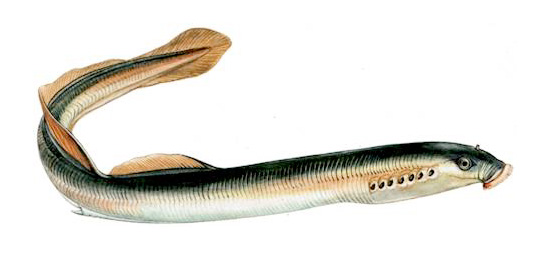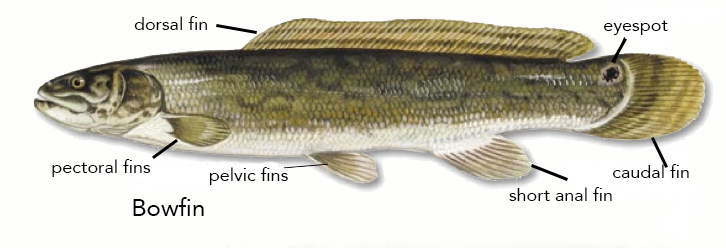|
Ginglymodi
Ginglymodi is a clade of ray-finned fish containing modern-day gars (Lepisosteidae) and their extinct relatives, including the family Lepidotidae and the orders Semionotiformes and Kyphosichthyiformes, and various other extinct taxa. Ginglymodi is one of the two major subgroups of the infraclass Holostei, the other one being Halecomorphi, which contains the bowfin and its fossil relatives. Fossil record The fossil record of ginglymodians goes back at least to the Anisian stage of the Triassic period, over 240 million years ago. ''Eosemionotus'' is one of the earliest ginglymodians. ''Acentrophorus'', another taxon from the Wuchiapingian stage of the late Permian, and ''Paracentrophorus'' from the Early Triassic epoch, could be even earlier members of the group. Ginglymodi was diverse and widespread during the Mesozoic era, but they represent a depauperate lineage today. The group first evolved in marine environments, but several lineages made separate tr ... [...More Info...] [...Related Items...] OR: [Wikipedia] [Google] [Baidu] |
Holostei
Holostei is a group of ray-finned bony fish. It is divided into two major clades, the Halecomorphi, represented by a single living species, the bowfin ('' Amia calva''), as well as the Ginglymodi, the sole living representatives being the gars (Lepisosteidae), represented by seven living species in two genera ('' Atractosteus'', ''Lepisosteus''). The earliest members of the clade appeared during the Early Triassic, over 250 million years ago. Holostei was thought to be regarded as paraphyletic. However, a recent study provided evidence that the Holostei are the closest living relates of the Teleostei, both within the Neopterygii. This was found from the morphology of the Holostei, for example presence of a paired vomer. Holosteans are closer to teleosts than are the chondrosteans, the other group intermediate between teleosts and cartilaginous fish, which are regarded as (at the nearest) a sister group to the Neopterigii. The spiracles of holosteans are reduced to vesti ... [...More Info...] [...Related Items...] OR: [Wikipedia] [Google] [Baidu] |
Neopterygii
Neopterygii (from Greek νέος ''neos'' 'new' and πτέρυξ ''pteryx'' 'fin') is a subclass of ray-finned fish (Actinopterygii). Neopterygii includes the Holostei and the Teleostei, of which the latter comprise the vast majority of extant fishes, and over half of all living vertebrate species. While living holosteans include only freshwater taxa, teleosts are diverse in both freshwater and marine environments. Many new species of teleosts are scientifically described each year. Fossil evidence for crown group neopterygians goes back at least 251 million years to the Induan stage of the Early Triassic epoch, however, one study incorporating morphological data from fossils and molecular data from nuclear and mitochondrial DNA, places this divergence date at least 284 mya (million years ago), during the Artinskian stage of the Early Permian. Another study suggests an even earlier split (360 myr ago, near the Devonian- Carboniferous boundary). Evolution and diversi ... [...More Info...] [...Related Items...] OR: [Wikipedia] [Google] [Baidu] |
Semionotiformes
Semionotiformes is an order of primitive, ray-finned, primarily freshwater fish from the Middle Triassic (Anisian) to the Late Cretaceous (Maastrichtian). The best-known genus is ''Semionotus'' of Europe and North America. Their closest living relatives are gars (Lepisosteidae), with both groups belonging to the clade Ginglymodi within the Holostei. Classification * Order †Semionotiformes Arambourg & Bertin 1958 sensu López-Arbarello 2012 ** Genus ?†'' Orthurus'' Kner 1866 ** Genus †'' Sangiorgioichthys'' Tintori & Lombardo 2007 ** Genus †'' Luoxiongichthys'' Wen et al. 2011 ** Genus †'' Aphanepygus'' Bassani 1879 ** Genus †'' Placidichthys'' Brito 2000 ** Family † Pleurolepididae Lütken 1871 *** Genus †'' Pleurolepis'' Agassiz 1863 non Quenstedt 1852 ** Family † Macrosemiidae Wagner 1860a corrig. Cope 1889 sensu Murray & Wilson 2009 acrosemii Wagner 1860a*** Genus †'' Eusemius'' Vetter 1881 *** Genus †'' Blenniomoeus'' Costa 1850 Calignathus.html" ;"tit ... [...More Info...] [...Related Items...] OR: [Wikipedia] [Google] [Baidu] |
Obaichthyidae
Obaichthyidae is an extinct family of ginglymodian ray-finned fish that lived in what is now Africa and South America during the Cretaceous period (Aptian– Cenomanian ages). It was erected in 2010 by Lance Grande to include the genera '' Dentilepisosteus'' and '' Obaichthys''. In 2012, it was defined as a stem-based taxon containing all taxa more closely related to ''Obaichthys'' than to the genera ''Lepisosteus'', '' Pliodetes'' or ''Lepidotes''. Obaichthyids were close relatives of the modern gars of the family Lepisosteidae Gars are members of the family Lepisosteidae, which are the only surviving members of the Ginglymodi, an ancient holosteian group of ray-finned fish, which first appeared during the Triassic, over 240 million years ago. Gars comprise seven l ..., with the two groups making up the superfamily Lepisosteoidea. References Lepisosteiformes Prehistoric ray-finned fish families Aptian first appearances Cenomanian extinctions {{Paleo-ray ... [...More Info...] [...Related Items...] OR: [Wikipedia] [Google] [Baidu] |
Lepisosteidae
Gars are members of the family Lepisosteidae, which are the only surviving members of the Ginglymodi, an ancient holosteian group of ray-finned fish, which first appeared during the Triassic, over 240 million years ago. Gars comprise seven living species of fish in two genera that inhabit fresh, brackish, and occasionally marine waters of eastern North America, Central America and Cuba in the Caribbean, though extinct members of the family were more widespread. Gars have elongated bodies that are heavily armored with ganoid scales, and fronted by similarly elongated jaws filled with long, sharp teeth. Gars are sometimes referred to as "garpike", but are not closely related to pike, which are in the fish family Esocidae. All of the gars are relatively large fish, but the alligator gar (''Atractosteus spatula'') is the largest; the alligator gar often grows to a length over and a weight over , and specimens of up to in length have been reported. Unusually, their vascular ... [...More Info...] [...Related Items...] OR: [Wikipedia] [Google] [Baidu] |
Halecomorphi
Halecomorphi is a taxon of ray-finned bony fish in the clade Neopterygii. The sole living Halecomorph is the bowfin (''Amia calva''), but the group contains many extinct species in several families (including Amiidae, Caturidae, Liodesmidae, Sinamiidae) in the order Amiiformes, as well as the extinct orders Ionoscopiformes, Panxianichthyiformes, and Parasemionotiformes. The fossil record of halecomorphs goes back at least to the Early Triassic epoch. The Halecomorphi exhibit a combination of ancestral features, such as most heavily mineralized scales, but also by more derived or "modern" features, particularly in the structure of the skull (e.g. position and shape of preopercles). Unique derived traits (synapomorphies) of the Halecomorphi include: *Unique jaw articulation in which the quadrate and symplectic participate in the joint. *Lengthened dorsal fins (in some species) *Two biconcave vertebrae per segment in the posterior body region (a condition known as d ... [...More Info...] [...Related Items...] OR: [Wikipedia] [Google] [Baidu] |
Ray-finned Fish
Actinopterygii (; ), members of which are known as ray-finned fishes, is a class of bony fish. They comprise over 50% of living vertebrate species. The ray-finned fishes are so called because their fins are webs of skin supported by bony or horny spines (rays), as opposed to the fleshy, lobed fins that characterize the class Sarcopterygii (lobe-finned fish). These actinopterygian fin rays attach directly to the proximal or basal skeletal elements, the radials, which represent the link or connection between these fins and the internal skeleton (e.g., pelvic and pectoral girdles). By species count, actinopterygians dominate the vertebrates, and they constitute nearly 99% of the over 30,000 species of fish. They are ubiquitous throughout freshwater and marine environments from the deep sea to the highest mountain streams. Extant species can range in size from '' Paedocypris'', at , to the massive ocean sunfish, at , and the long-bodied oarfish, at . The vast majority of Actino ... [...More Info...] [...Related Items...] OR: [Wikipedia] [Google] [Baidu] |
Macrosemimimus
''Macrosemimimus'' is an extinct Extinction is the termination of a kind of organism or of a group of kinds (taxon), usually a species. The moment of extinction is generally considered to be the death of the last individual of the species, although the capacity to breed and ... genus of semionotiform ray-finned fish from the Late Jurassic of Germany, England and France. References Semionotiformes Jurassic animals of Europe {{Jurassic-fish-stub ... [...More Info...] [...Related Items...] OR: [Wikipedia] [Google] [Baidu] |
Lepidotidae
Lepidotidae is an extinct family of fish, known from the Jurassic and Cretaceous periods. Most species were originally assigned to the genus ''Lepidotes'' which was long considered a wastebasket taxon. Cladistic analysis has indicated that they are close relatives of gars, with both being members of the order Lepisosteiformes. Members of the family are known from both marine and freshwater environments. ''Lepidotes sensu stricto'' had peg-like grasping marginal teeth and crushing palatal teeth, and is known to have consumed small crustaceans, while ''Scheenstia'' had low rounded crushing marginal teeth, indicating a durophagous diet. Taxonomy * ''Lepidotes'' Agassiz, 1832 * ''Scheenstia ''Scheenstia'' is an extinct genus of neopterygian ray-finned fish from the Late Jurassic–Early Cretaceous of Europe. Fossils have been found in both marine and freshwater environments. Most species of the genus were previously referred to the r ...'' López-Arbarello & Sferco, 2011 * '' ... [...More Info...] [...Related Items...] OR: [Wikipedia] [Google] [Baidu] |
Araripelepidotes
''Araripelepidotes'' is a genus of ginglymodian fish. Habitat ''Araripelepidotes'' was probably endemic to the Araripe Basin, and was commonly found in Santana formation, and rare in the Crato Formation, mostly in carbonate concretions, but uncommon in laminated limestones. Taxonomic history The type species ''A. temnurus'' was formerly placed in the genus ''Lepidotes'', until it was moved to the new genus in 1990. Paleoecology ''Araripelepidotes'' was likely a toothless suction feeder, due to the development of its mobile maxilla and the presence of an interoperculum, and would have inhabited estuarine and freshwater environments. It is the only semionotidid known from the Araripe Basin, except for Lepidotes wenzae ''Lepidotes'' (from el, λεπιδωτός , 'covered with scales') (previously known as ''Lepidotus'') is an extinct genus of Mesozoic ray-finned fish. It has been considered a wastebasket taxon, characterised by "general features, such as thic .... R ... [...More Info...] [...Related Items...] OR: [Wikipedia] [Google] [Baidu] |
Fossil
A fossil (from Classical Latin , ) is any preserved remains, impression, or trace of any once-living thing from a past geological age. Examples include bones, shells, exoskeletons, stone imprints of animals or microbes, objects preserved in amber, hair, petrified wood and DNA remnants. The totality of fossils is known as the ''fossil record''. Paleontology is the study of fossils: their age, method of formation, and evolutionary significance. Specimens are usually considered to be fossils if they are over 10,000 years old. The oldest fossils are around 3.48 billion years old to 4.1 billion years old. Early edition, published online before print. The observation in the 19th century that certain fossils were associated with certain rock strata led to the recognition of a geological timescale and the relative ages of different fossils. The development of radiometric dating techniques in the early 20th century allowed scientists to quantitatively measure the abs ... [...More Info...] [...Related Items...] OR: [Wikipedia] [Google] [Baidu] |
Bowfin
The bowfin (''Amia calva'') is a bony fish, native to North America. Common names include mudfish, mud pike, dogfish, grindle, grinnel, swamp trout, and choupique. It is regarded as a relict, being the sole surviving species of the Halecomorphi, a group of fish that first appeared during the Early Triassic, around 250 million years ago. The bowfin is often considered a " primitive fish" because they have retained some morphological characteristics of their early ancestors. The closest living relatives of bowfins are gars, with the two groups being united in the clade Holostei. Bowfins are demersal freshwater piscivores, commonly found throughout much of the eastern United States, and in southern Ontario and Quebec. Fossil deposits indicate Amiiformes were once widespread in both freshwater and marine environments across North and South America, Europe, Asia, and Africa. Now, their range is limited to much of the eastern United States and adjacent southern Canada, including ... [...More Info...] [...Related Items...] OR: [Wikipedia] [Google] [Baidu] |
.jpg)




